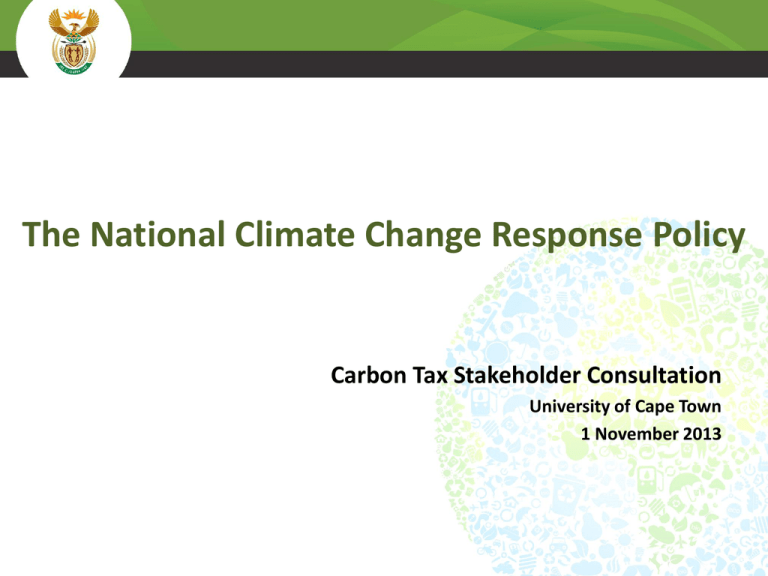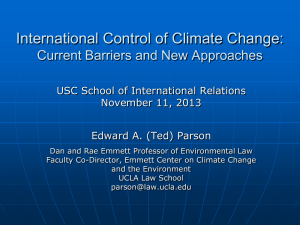The National Climate Change Response Policy – - erc
advertisement

The National Climate Change Response Policy Carbon Tax Stakeholder Consultation University of Cape Town 1 November 2013 National Climate Change Response Policy VISION Transition to a climate resilient and lower-carbon economy and society National Climate Change Response Policy OBJECTIVE Manage CC impacts through interventions that build & sustain SA’s social, economic & environmental resilience OBJECTIVE Make a fair contribution to the global effort to stabilize GHG concentrations…….. Overall approach Needs driven and customised: employing a wide range of different approaches, tailored for the specific actors, organisations, sectors Developmental: prioritising climate change responses that have significant mitigation / adaptation benefits, AND have significant economic growth, job creation, public health, risk management and poverty alleviation benefits. Transformational, empowering and participatory: address climate change at a scale of economy that supports the required innovation and finance flows needed for a transition to a lower carbon, efficient, job creating, equitable and competitive economy Dynamic and evidence based: Build on existing successful policies and measures, ensuring policy alignment, and scaling up Key elements of mitigation • Build on what already exists • Assess mitigation potential in key sectors and identify a set of viable options for reducing GHGs in key sectors • Assess socio-economic costs /benefits of mitigation opportunities • Develop desired emission reduction outcomes (DEROs) per sector • Agree on the optimal combination of measures, appropriate to each sector, to achieve the DEROs (including the carbon tax, carbon budgeting approach, setting of efficiency targets, use of standards and regulation etc). • Sectors / sub-sectors to formulate mitigation plans, to achieve DEROs • Monitoring and evaluation Sectors: energy, industry, transport, waste & agriculture, Key issues: Pricing carbon is key to driving transition to a green economy Part of the spectrum of measures available to achieve emission reductions How to integrate the carbon tax with other measures to achieve emission reductions, increased energy efficiency AND increased productivity , competitiveness and local manufacturing of green technologies Options for the carbon tax to interface with measures for achieving emission reductions depend primarily on the level and nature of the emission reduction outcomes, per sector Key issues cont... The carbon tax could be dovetailed with the process of setting desired emission reduction outcomes (DEROs) • Use the tax as a compliance tool, in relation to the set emission reduction objectives per sector (and measures to achieve them), in order to drive energy efficiency, improve productivity and increase investment in green technology • Each sector has specific characteristics and dynamics - decisions on sector threshold levels and on the optimal combination of measures or instruments to achieve emission reductions need to be informed by an assessment of sector characteristics National Atmospheric Emissions Inventory System (NAEIS) NAEIS System overview Emission Summary Tables Activity Data Sub-Module Emissions Processing: the heart of the EI inventory module Emissions Reporting Public Interface for emissions results Inventory results are documented and archived EmissionFactor Sub-Module E = M x EF What pollutants are included in NAEIS Pollutant South Africa NAAQS NAEIS Capability Yes Yes 1. Criteria Pollutants PM, SO2, NOx, CO, Benzene, Dust, Lead • Other metals (Arsenic, Cadmium, Nickel, etc.) Yes 2. Hazardous Air Pollutants (HAPs) Yes 3. Volatile Organic Chemicals (VOCs) Yes 4. Green House Gasses (GHGs) Yes Emission Summary Tables Activity Data Sub-Module Emissions Processing: the heart of the EI inventory module Emissions Reporting Public Interface for emissions results Inventory results are documented and archived EmissionFactor Sub-Module E = M x EF About the Activity Data module Activity Data Sub-Module • On-line forms and file submission functionality • Emitter has joint control of information on the EI system (own access, generate facility-level reports) • Supporting documents (evidence) upload function • Multiple authority platforms [single tool, multi-authority access] • Cater for top-down and bottom-up information requirements • QA/QC tool [Virus, formatting, completeness, internal consistency checks, calculation errors] • Real-time validation [Historical and defined thresholds] Emission Summary Tables Activity Data Sub-Module Emissions Processing: the heart of the EI inventory module Emissions Reporting Public Interface for emissions results Inventory results are documented and archived EmissionFactor Sub-Module E = M x EF EmissionFactor Sub-Module About the EF module System has default and country specific emission/plant-specific emission factors Database of emission factors accessible to all users Metadata about the EF in the database EmissionFactor Sub-Module NAEIS emissions factor library Emission Summary Tables Activity Data Sub-Module Emissions Processing: the heart of the EI inventory module Emissions Reporting Public Interface for emissions results Inventory results are documented and archived EmissionFactor Sub-Module E = M x EF About the Processing module Emissions Processing: the heart of the EI inventory module • Emissions calculation algorithms based on the 2006 IPCC guideline methodologies • Module allows for top-down and bottom-up methodologies Allow for time series development of AD, EF and Emissions Results • Allow for recalculations when new AD and EF is available • Historical and recalculated data should be kept by the system (archiving) System handles both pollutants and GHGs IPCC Sectors (GHG Emissions) Sec 21 ( Air pollutant emissions) Energy Non-energy use and feedstock Combustion: Stationery + Mobile Process Emissions Waste Fugitive Energy IP + PU Production of Primary and Secondary fuels Energy Recovery Pulp + Paper: Forest Management A+FO+LU Waste Emission Summary Tables Activity Data Sub-Module Emissions Processing: the heart of the EI inventory module Emissions Reporting Public Interface for emissions results Inventory results are documented and archived EmissionFactor Sub-Module E = M x EF About the Reporting module Emissions Reporting • System is able to package data based on sectoral, provincial, local, national level, (see next slide) • Multiple export formats (current and historical data) • A public interface developed for ease of access by the general public • System is linked with GIS functionality • Inventory results are documented and archived Data Mining • Search emission data by • Pollutants, Year, Location, Sector System Implementation • • • • System will go-live in January 2014 Reporting period – calendar year Mandatory reporting – January 2015 Reporting regulations – April 2013 THANK YOU







